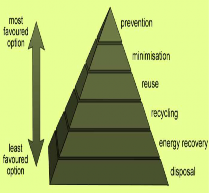Solid Waste Management and Energy from Wastage
♤ About 55 million tonnes of waste is generated every year and expected to cross 125 million tonnes by 2030.
♤ Much of this waste is dumped on outskirts of cities with no compliance or regulation. Vehicles transporting these waste are not totally covered up and littering of waste, causing breeding of waste and flies which affect public health.
♤ Municipal waste: It includes domestic waste either in solid or semi solid form. About 115,000 tonnes of municipal waste is generated every day with a yearly increase of 5%. It is broadly classified as:
o Biodegradable Waste: Food and Kitchen waste, Green Waste
o Recyclable Material:Paper, Glass, Bottles, Plastics, Fabrics etc.
o Insert Waste: Soil, Pebbles, Dirt, and Ash etc.
♤ About 25% of municipal waste is not collected at all and the authorities don’t have preparedness to set up waste processing and disposal facilities.
There are various methodologies available for the treatment of solid waste.
♤ Waste Management Hierarchy


♤ Land Filling
o It is a technique for the disposal of waste into or onto the land.
o In this method transportation costs are generally high as the landfill sites are far away from cities.
o Two major green house gases Carbon Dioxide and Methane get emitted in this method.
